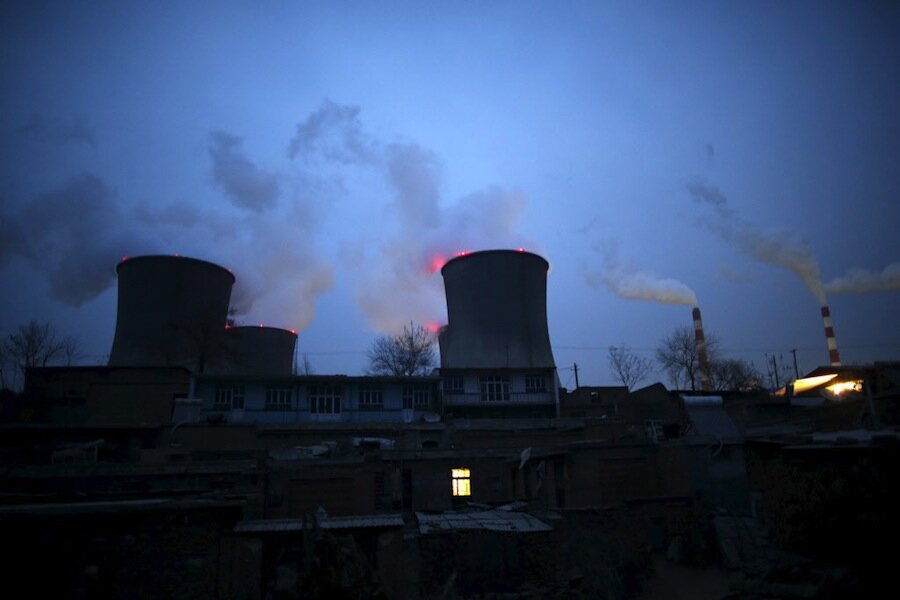World could peak emissions by 2020, IEA says. But will it?
Loading...
| Washington
With just six months until global climate talks, there’s a gap between the modest emissions cuts countries have promised and the bold cuts scientists say are needed to prevent the worst global warming impacts.
The International Energy Agency released a report Monday detailing how world leaders can keep warming within 2 degrees Celsius. And while IEA says that target can be met “at no net economic cost,” Monday’s report indicates that, for now, the world is not on track to stop the planet from warming more than 2 degrees Celsius, or 3.6 degrees Fahrenheit.
Of greatest concern among analysts is that, with each passing year, limiting temperature rise becomes more and more difficult.
“[T]ime is of the essence,” Maria van der Hoeven, executive director of the IEA, said in a statement Monday. Ms. van der Hoeven pointed out that past analysis has shown “the cost and difficulty of mitigating greenhouse-gas emissions increases every year.”
Limiting warming to 2 degrees above pre-industrial levels is the internationally agreed-upon goal for UN climate talks in Paris this December. Talks aim to broker a global deal slashing planet-warming emissions from human activity, like burning fossil fuels in power plants, cars, and airplanes.
In the report, IEA analyzed the pledges countries have made so far towards December’s negotiations on a global climate deal. The report found that if more ambitious action on climate change doesn’t come after 2030, the current path would lead to an average temperature increase of about 2.6 degrees Celsius by 2100, and 3.5 degrees Celsius after 2200.
If that happens, "we can say goodbye to the planet we have seen for centuries," IEA chief economist Fatih Birol told reporters in London.
So far, the US, EU, Russia, and other countries in the developing world have put forward emissions-cutting promises. The US has pledged to cut emissions 26 to 28 percent below 2005 levels by 2025. Across the Atlantic, the EU has pledged to cut emissions 40 percent below 1990 levels by 2030. Negotiators will stitch those pledges together with the rest of the world’s to cement a global agreement come December.
But the developing world – whose emissions are only expected to grow as poor countries industrialize – has not put forward many substantial commitments yet. And IEA’s analysis suggests rich countries' current targets don’t make for a promising trajectory, either.
IEA lays out four pillars to successful climate talks in Monday's report. The No. 1 goal is to peak emissions as early as 2020. The other three pillars involve setting up a five-year revision process, so emissions cuts can be revisited and emboldened down the road; establishing a collective long-term emissions cutting goal; and putting together a process for tracking the energy sector’s achievements toward slashing emissions.
“Any climate agreement ... must have the energy sector at its core or risk being judged a failure,” Mr. Birol said in a statement, adding that climate pledges for the Paris talks “are an important first step to meeting our climate goal, and our report shows that they will have a material impact on future energy trends.”
Ending fossil fuel subsidies around the world, cutting methane emissions, ending construction of coal plants, and boosting investment in renewables are among IEA’s recommendations for peaking emissions as early as 2020.
The report does underscore one hopeful trend: The decoupling of economic growth and emissions growth. World economics will grow 88 percent between 2013 and 2030, the report finds, but carbon dioxide emission from the energy industry will grow only 8 percent.
In the past, upticks in economic growth were highly correlated with upticks in planet-warming emissions.
“This report shows that with concerted effort the world could achieve a peak in emissions as soon as 2020 – without putting a damper on economic growth,” Fred Krupp, president of Environmental Defense Fund, an environmental group, said in a statement Monday. “The first step to any long-term climate goal is to turn the corner on global emissions so that they stop rising and start falling.”
News out of China – the world’s biggest carbon polluter – has given negotiators hope that reining in warming will be possible. A report from the London School of Economics last week indicates China may peak its emissions five years earlier than anticipated.
“This finding suggests it is increasingly likely that the world will avoid global warming of more than 2C above pre-industrial levels,” study authors Fergus Green and Nicholas Stern said in a statement.







